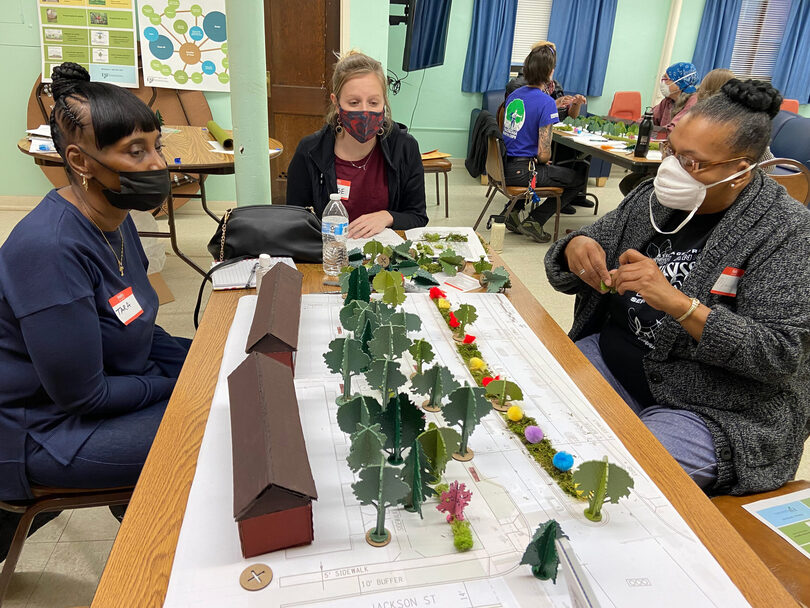SUNY ESF uses virtual reality to envision the future of the I-81 Viaduct Project

Researchers from ESF’s Department of Landscape Architecture are using feedback from residents of Pioneer Homes for their designs and virtual reality to map out potential landscapes for the area after the highway viaduct comes down. Courtesy of Maren King
Get the latest Syracuse news delivered right to your inbox.
Subscribe to our newsletter here.
As the city of Syracuse prepares to move from the current I-81 viaduct to the community grid, researchers from SUNY ESF have partnered with residents of Pioneer Homes, one of the first public housing developments in the country, to design what the area’s future landscape may look like.
“I thought if we had a process where we could truly engage community members in understanding what was gonna happen … that (it) would be helpful to the people who are actually designing both the road infrastructure as well as the landscape infrastructure,” said Maren King, an emeritus associate professor of landscape architecture at ESF leading the project.
Pioneer Homes is one of Syracuse’s poorest areas due to segregation from redlining and I-81 itself. Researchers from ESF’s Department of Landscape Architecture are using residents’ feedback for their designs and virtual reality to map out potential landscapes for the area after the highway viaduct comes down.
The project, which is not affiliated with the New York State Department of Transportation’s I-81 Viaduct Project, targets two problems at once, King said. The designs would not only answer the question of what happens in the neighborhood once the viaduct comes down, but would also help further Syracuse’s Urban Forest Master Plan, which aims to increase Syracuse’s tree canopy.
“If you’re going to spend millions of dollars on trees, which they are likely going to do, then there should be attention paid to what’s the composition of that urban forest, what’s the design of it,” King said.
Twelve Pioneer Homes residents began the process by discussing the values and benefits of trees and urban landscape with researchers, King said. Participants then worked in small groups to model potential aspects of the landscape, such as trees to filter air quality. Participants received a stipend for their contributions.

The design process will continue for the rest of the 2023-24 school year before the final designs are delivered to the Pioneer Homes residents, and possibly the broader Syracuse community, for review, King said.
Courtesy of Maren King
King said the ideas were then modeled virtually and shown to the participants for further discussion.
After formulating multiple designs, the researchers are working to implement them into virtual reality. With the help of virtual reality forests, a tool developed by ESF professor Aidan Ackerman, faculty and students from ESF are trying to make these ideas come to life.
“There’s so many moving pieces,” said Ackerman, an associate professor of landscape architecture. “Using the software as an advocacy tool for our rich urban forest along the community grid and being able to bring together different ways that we think about it (is important).”
Both King and Ackerman said student involvement has been instrumental to their research, both in working with the Pioneer Home groups and with VR. Scott Shannon and Emanuel Carter, two other landscape architecture professors at ESF, led a design studio last spring to involve students in the project, King said.
Tanner Laramee, second-year masters student at ESF studying landscape architecture, spent the summer working with Ackerman on the virtual forest technology. Laramee said the technology gives residents a unique chance to get involved with and influence a significant local project.
“It’s giving the community a chance to really understand the project that’s going on, and the different types of changes that their backyards and their homes are going to experience,” Laramee said.
This direct communication with local residents, he said, is more informative than typical governmental meetings. It gives residents “first-hand experience” of what the area might look like in the future, Laramee said.
Though Ackerman’s technology has been used across the country for many virtual forest projects, connecting it to the community he lives in was especially meaningful, he said.
“All these projects I’m working on have different audiences and impacts, but at the end of the day, I think really using these tools locally to connect with community and planning and policy is probably the ultimate thing we should be focusing on,” Ackerman said.
The design process will continue for the rest of the 2023-24 school year before the final designs are delivered to the Pioneer Homes residents, and possibly the broader Syracuse community, for review, King said.
King said she submitted a proposal to implement the project’s results to Joe Driscoll, the city of Syracuse’s I-81 project director, and Mark Frechette, the former lead engineer of the state’s I-81 project. For King, though, the most important part has been the engagement with residents.
“We’re not doing a bigger project in terms of, ‘Here’s our proposal for this whole area’,” King said. “It’s, ‘Here’s research that we’re doing with community members.’”





